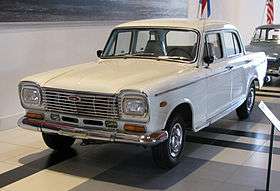Shanghai SH760
| |
|---|---|
 A 1986 Shanghai SH760B | |
| Overview | |
| Manufacturer |
|
| Also called | Shanghai SH7221 |
| Production | 1958-1991 |
| Body and chassis | |
| Body style | 4-door sedan |
| Powertrain | |
| Engine | 2.2 L I6 (copy of Mercedes-Benz M127) |
| Transmission | 4-speed manual |
| Chronology | |
| Successor | Shanghai-Volkswagen Santana |
The Shanghai SH760 is a car produced in China from 1958 to 1991[1] primarily for government officials not important enough to warrant a FAW Hong Qi.[2] The design was based on the Mercedes-Benz 220S (W180) model of the mid-1950s, with modified front and rear styling.[3] Originally built by the Shanghai City Agricultural Machinery Manufacturing Company, this became STAC (Shanghai Tractor and Automobile Corporation) in April 1969. The company changed its name to SATIC (Shanghai Automobile and Tractor Industry Corporation) in the mid-1980s and became SAIC in 1990.[4] Unlike Beijing-controlled FAW and SAW, STAC was owned directly by the city of Shanghai.[3]

The Shanghai Automobile assembly line produced its first car on 28 September 1958, called Fenghuang (meaning Phoenix in English). It was also the first production car produced in China. Only very few Phoenix sedans were produced between then and 1960.[5] The Phoenix models are distinguished by round headlights and fins to the rear.[6]
In December 1964, a modified Phoenix changed its name to Shanghai SH760, and by 1965 it was in full production. A mere fifty cars were built in 1964, but by the mid-seventies factory capacity stood at 5,000 per annum.[1] In 1968 and 1974, the SH760 underwent a series of cosmetic updates (SH760A and SH760B respectively). The final SH760 was produced on 25 November 1991, after a total production run of 79,526 cars. Production peaked in 1984 at around 6,000 units.[5] The last model in the series was the SH7221, which also received a variety of Santana parts. The bumpers, taillights (somewhat modified), and some interior parts came straight from the Santana, even though this was in direct contradiction to Shanghai's contract with Volkswagen.[7] The SH7221 also had a blacked out plastic grille in the front.
The SH760 was powered by a 2.2 litre straight-six engine developing 90 bhp (67 kW; 91 PS) and coupled with a four-speed manual gearbox.[5] As with the basis of the bodywork, this was a copy of 1950s Mercedes-Benz mechanicals. Construction was by hand, with old-fashioned methods and on a small scale. A 1985 visitor described the process as chaotic, with many body parts rusting before they were even painted - but since the metal was so thick, this was not an issue, as they would still easily outlast the engine and transmission.
References
- Works cited
- Posth, Martin (2006), 1000 Days in Shanghai, Singapore: John Wiley & Sons (Asia), ISBN 978-0-470-82388-0
- Citations
- 1 2 3 "SAIC History". SAIC Motor. Archived from the original on 2010-05-25.
- ↑ "The home team". The Economist. 13 November 2008. Retrieved 5 November 2011.
- 1 2 Posth, p. 4
- ↑ Posth, p. 20
- 1 2 3 "The Chinese Car Industry". Society for Anglo-Chinese Understanding. Retrieved 5 November 2011.
- ↑ "Historic photographs". SAIC. Retrieved 8 January 2012.
- ↑ Posth, p. 36
